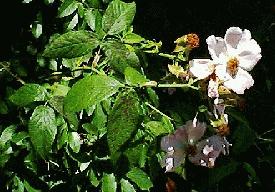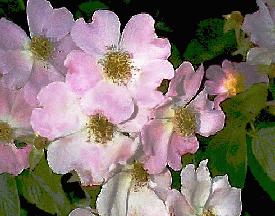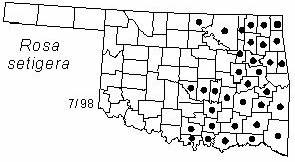

Climbing vine to 5 m (15 ft) tall. Twigs green-red, glabrous; scattered prickles, broad at the base, 4-8 mm (0.15-0.3 in) long. Leaves alternate, pinnately compound, leaflets 3 (occasionally 5 or 7); leaflets lanceolate to oblong, 4-10 cm (1.5-4 in) long; glabrous above, occasionally glandular on veins; dark green above, paler beneath; acute at base; acute, acuminate, or rounded at apex; margins serrate; petiole glandular-hispid with a few prickles; stipules adnate, 1-2 cm (0.4-0.8 in) long, margins entire, ciliate or glandular; rachis glandular-hispid with a few prickles. Inflorescence a corymb with numerous flowers, glandular-hispid; sepals 5, lanceolate, glandular-hispid above; petals 5, rose or white, 3-3.5 cm (1.2-1.4 in) long; styles united into a column, exserted; stamens numerous; flowers appear from May to June. Fruit a hip, 0.8-1.3 cm (0.3-0.5 in) diameter, globose to ellipsoid, red; nutlets numerous, smooth with a few hairs, yellow; fruits mature in September.
Distribution: Oklahoma, Arkansas, and Texas, east to Florida, north to New York, west through Indiana to Kansas. Common.
Habitat: fencerows and thickets.
Comment: Rosa is the classical name for roses; setigera means bristle-bearing.
Field identification: Prairie rose is our only species with three leaflets.
Food uses: rose hips are an excellent source of vitamin C (60 times the concentration of lemons).
Wildlife benefits: fruits are eaten by a variety of birds and mammals; the stems are browsed by deer.
NWI status: FACU-
Distribution in Oklahoma: 
BACK
NEXT
RETURN TO INDEX
Last update: 9/17/99
 Go to Oklahoma Biological Survey Home Page
Go to Oklahoma Biological Survey Home Page
 Disclaimer
Disclaimer